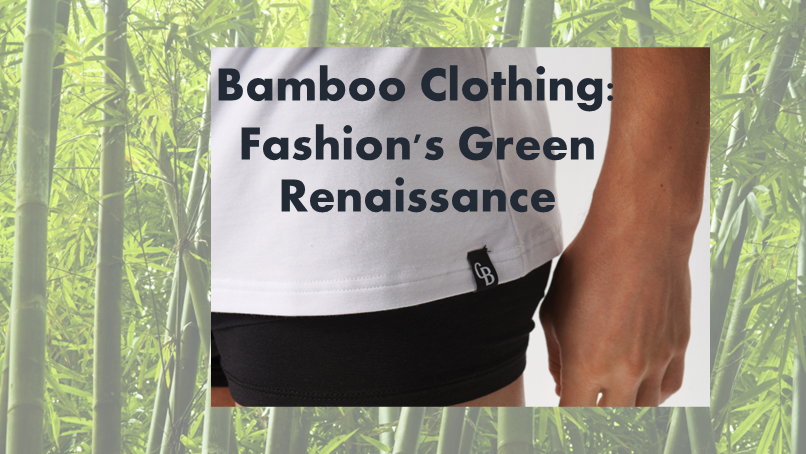
The fast fashion industry has long been plagued by harmful environmental and social impacts, from excessive water consumption to exploitative labor practices. However, a new trend is emerging in the fashion world: sustainable clothing. At the forefront of this movement is bamboo clothing, offering a stylish alternative with a conscience.
This article will explore the rise of bamboo clothing, its sustainable qualities, ethical considerations, advancements in production, and the role of consumers in driving the demand for a more sustainable fashion industry.
Sustainable Qualities of Bamboo Clothing
Bamboo clothing possesses several sustainable qualities that set it apart from conventional fabrics. Firstly, bamboo is biodegradable, meaning it can naturally decompose without releasing harmful pollutants into the environment. Bamboo offers a more environmentally friendly alternative, unlike synthetic fibers that take centuries to break down.Moreover, bamboo fabric has inherent antibacterial properties, making it ideal for bamboo men's underwear, activewear, and other undergarments. Furthermore, bamboo also possesses odor-resistant properties, eliminating the need for chemical treatments commonly used in conventional textiles.
The Environmental and Social Aftermath of Fast Fashion
The fast fashion industry has come under scrutiny for its detrimental environmental and societal effects. The excessive use of water, chemicals, and energy in production processes contributes to pollution and resource depletion.Additionally, exploitative labor practices and unsafe working conditions are prevalent. These issues highlight the need for sustainable alternatives that prioritize the well-being of people and the planet.
Understanding Bamboo's Role in Sustainable Clothing
Sustainable clothing aims to minimize negative impacts on the environment and society. It involves using eco-friendly materials, adopting responsible manufacturing processes, and ensuring fair treatment of workers. By breaking away from the destructive cycle of fast fashion, sustainable clothing promotes ethical and environmentally conscious fashion choices.Bamboo has gained attention as a renewable resource for clothing production. It is a fast-growing plant that requires no pesticides or fertilizers, making it naturally organic. It can be harvested in as little as three to five years, in stark contrast to the decades required for traditional timber trees to mature. This rapid growth rate makes bamboo highly sustainable and helps combat deforestation.
Additionally, bamboo clothing provides excellent UV protection, filtering up to 98% of harmful rays. This natural sun protection factor makes bamboo clothing popular for outdoor enthusiasts and individuals in sunny climates.
Related post: Why Bamboo Sheets Are Today's Luxury Bedding
Leading the Way in Sustainable Fashion
Within the realm of sustainable fashion, bamboo clothing has gained significant traction, attracting the attention of both consumers and industry leaders.Several brands like Cophenhagen Bamboo have taken the lead in embracing bamboo as a critical component of their sustainable fashion lines, setting an inspiring example for the rest of the industry. These brands' and designers' embrace of bamboo clothing demonstrates their commitment to sustainability. It highlights the growing demand for eco-friendly fashion.
Consumers increasingly seek alternatives that align with their values and bamboo clothing provides a viable solution. The success and popularity of these brands and designers indicate a shift in consumer preferences, with more individuals recognizing the importance of sustainable fashion choices.
Bamboo and Climate Change
In addition to its sustainable qualities, bamboo clothing also has the potential to contribute to climate change mitigation. Bamboo plants are renowned for absorbing enormous amounts of atmospheric carbon dioxide, acting as a natural carbon sink.As bamboo forests expand, they can help offset greenhouse gas emissions and combat climate change. Furthermore, bamboo cultivation requires less water than other crops, reducing pressure on freshwater resources.
By choosing bamboo clothing, consumers can positively impact the environment by supporting a renewable resource that actively contributes to the fight against climate change.
The Role of Consumers
Consumers hold the power to drive the demand for bamboo clothing and promote a shift towards a more sustainable fashion industry.By supporting these brands and designers, consumers contribute to the growth of the sustainable fashion movement. They send a powerful message to the fashion industry, encouraging other brands to adopt sustainable practices and invest in eco-friendly materials like bamboo.
Together, consumers and industry leaders can drive the transformation of the fashion landscape, promoting a future where sustainability and style go hand in hand.
Final Thoughts: The Future of Fast Fashion
While traditional methods of bamboo production rely on harsh chemicals, advancements have been made to develop more sustainable and eco-friendly processes. Innovations in manufacturing technologies and techniques aim to minimize the environmental impact of bamboo textile production.The rise of bamboo clothing offers a compelling solution to the environmental and social issues associated with the fast fashion industry. Bamboo's renewable and organic nature provides a sustainable alternative to conventional fabrics. Its biodegradability, antibacterial properties, and UV protection make it an attractive choice for conscious consumers. Ultimately, by supporting sustainable brands and making informed choices, consumers can drive the demand for bamboo clothing and promote a more sustainable fashion future.
This article is contributed by Cophenhagen Bamboo team.
